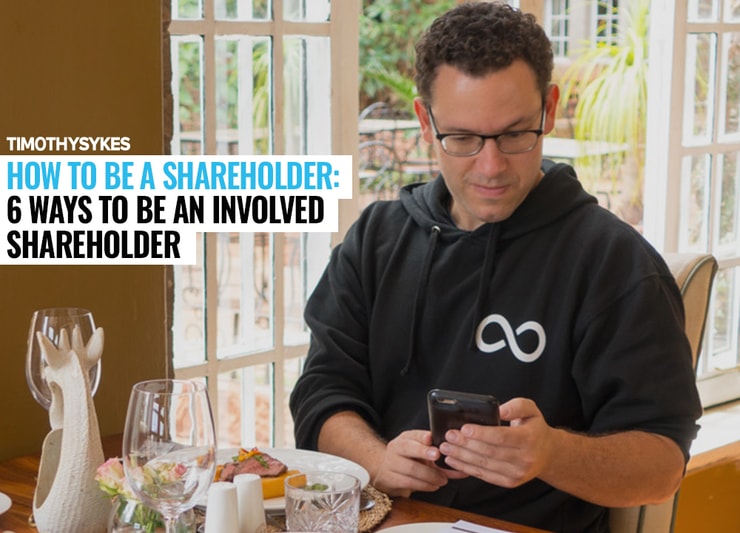If you bought stock in a company, you’re officially a shareholder. Congratulations! Now you can choose to either sit back and watch what happens, or play an active role in the company’s developments. If you’re interested in the latter, then here are six ways you can help make it happen.
Table of Contents
Attend Meetings

2025 Millionaire Media, LLCSo, how to be an involved shareholder? As a shareholder of a public corporation, you’ll be invited to listen in on shareholder calls or attend shareholder meetings. Don’t skip these.
Many companies hold annual general meetings, which give you a chance to co-mingle with company directors. The general purpose of these meetings is to provide an overview of the previous fiscal year’s performance. They also provide a platform for directors to share new company initiatives.
If you’re interested in the company’s long-term viability, the annual meeting provides an opportunity to ask probing questions and glean insights to information that’s yet to be made public.
These gatherings also give you the chance to directly participate in an organization’s evolution. Most meetings include opportunities to vote on new board member elections and potential new company initiatives.
Use Your Voice
At the 2018 annual Apple meeting, shareholders got to vote for a proposed human rights commission. While the vote didn’t pass, it serves as an excellent example of the influence single shareholders can potentially play on a company’s overall direction.
In 2017, Jing Zhao, an Apple shareholder with a small stake in the company (just $2,000 in stock at the time), proposed that the tech giant should form a human rights committee to review and make recommendations to enhance the company’s commitment to human rights initiatives.
Zhao’s reform pursuit could have had major long-term implications on the company’s programs and public perception. He didn’t let his relatively small stake in the mega-corporation stop him from spearheading growth. His campaign proves that any shareholder, big or small, has the opportunity to amplify a message and make a difference in the business.
The Walt Disney Company’s 2018 annual meeting gave shareholders the chance to vote on a number of issues. One of the agenda items was the election of new board members. The shareholders in attendance ultimately voted in 10 directors.
Another issue on the floor at the 2018 Disney gathering was an executive pay plan, which was ultimately rejected in a non-binding vote. As covered by the Los Angeles Times, 52 percent of shareholders in attendance nixed the plan. Many voters may have been influenced by other Disney company stakeholders (including resort and park workers) picketing the Houston, Texas meeting, as several unions were attempting to negotiate new contracts.
By choosing to participate in the future interests of the company, these shareholders had a chance to serve the interests of stakeholders and company workers whose voices aren’t as loud as those at the executive level. Their ability to vote on — and ultimately reject — the executive pay plan served as an act of protection for the company’s workers.
On a lighter note, the gathering also gave shareholders in attendance previews of the organization’s future projects, including the announcement of a Star Wars television show.
More Breaking News
- Wolfspeed Shares Skyrocket: What’s Next?
- Why Rocket Lab Stock Might Rally?
- GNS Stock Rises Amid Key Market Moves and Financial Indicators
It takes a LOT of people to run a public corporation. While shareholders are often external individuals and organizations not employed by the company itself, the proposals that they vote for or against at annual meetings can have major ramifications of the livelihoods of the company’s greater stakeholders.
Think of the Stakeholders
What are stakeholders? Here’s a solid, basic stakeholder definition from BusinessDictionary:
A person, group or organization that has interest or concern in an organization.
Stakeholders can affect or be affected by the organization’s actions, objectives and policies. Some examples of key stakeholders are creditors, directors, employees, government (and its agencies), owners (shareholders), suppliers, unions, and the community from which the business draws its resources.
Not all stakeholders are equal. A company’s customers are entitled to fair trading practices but they are not entitled to the same consideration as the company’s employees.
This means that consumers are also the stakeholders of any corporation. The viability and direction of that overall business could have a direct impact on their lives.
In many ways, stakeholders depend on shareholders.
When you buy shares of an organization, your financial support can be used as financial backing for, say, new research or marketing initiatives, which often has an impact on workers in those departments.
The Disney example shows that shareholders’ voting and participation can directly affect company employees. It’s not to be taken lightly.
Just as much as shareholders impact the lives of stakeholders, especially employees, the reverse is also true. Motivation — how well a company’s workforce performs — can impact an organization’s profits, and ultimately, stock valuation.
In 2012, American Express (AE) published a story about a 2009 study conducted by Kenexa, which found that companies with engaged employees had a higher shareholder return rate. The AE story also featured a Towers Perrin study, which found that companies with motivated teams elicited higher net-profit margins.
If you think about it, this relationship makes sense. Engaged employees not only create higher quality output, but also serve as natural brand evangelists, which can spread awareness and aid in profit growth.
Clearly, the relationship between stakeholders (employees, especially) and shareholders is symbiotic — both need the support of the other to flourish.
Keep Tabs on the Board of Directors
Shareholders and board directors are both entities whose best interests lie in the company’s ability to grow and continue increasing profit. However, in terms of voice and responsibility, their difference is vast.
Like the relationship between stakeholders and shareholders, board directors and shareholders also have a mutually beneficial (or potentially destructive) relationship with one another.
Investopedia defines a board of directors as:
A group of individuals, elected to represent shareholders. A board’s mandate is to establish policies for corporate management and oversight, making decisions on major company issues. Every public company must have a board of directors. Some private and nonprofit organizations also have a board of directors.
Shareholders elect a board of directors to act on their behalves. In many ways, the board runs checks and balances on the overall operation and internal leadership of an organization. A board is responsible for naming C-level executives, determining compensations, and reviewing an organization’s financial statements.
Many shareholders assume that the board members they elect will always act in their best interest. But that’s doesn’t always happen. If shareholders feel underrepresented or ignored, many will vote on new board elections or simply sell their shares in the company and bow out.
If shareholders sense that there are organizational inefficiencies, they should attend annual meetings because it’s a good chance to share concerns and vote on board matters.
For a company to operate at the highest level, all parties — shareholders, stakeholders and board members — must share interests and work together.
When shareholders make the effort to participate by attending annual meetings or listening in on quarterly earnings calls, it gives them the opportunity to survey the progress of an organization beyond just the rise and fall of the stock performance.
Make the Most of Your Status

2025 Millionaire Media, LLCIf you’re a shareholder, it’s completely up to you to determine how much or little you invest in a company and, subsequently, how much or little you participate.
It’s important to remember that regardless of how many or few shares you buy, your voice can make a difference. Moreover, your decision to use your voice can directly impact both the lives of stakeholders and the organization’s board of directors.
If you already own shares and want to make a greater impact by attending your first meeting, go in with a gameplan. Yes, annual meetings offer an opportunity to network with company executives and meet and connect with other shareholders, but beyond the socialization aspect, they can also serve as a soapbox.
At these meetings you have the chance to ask probing questions that could force other key stakeholders and board members to think further about — and possibly reassess — their stances on company initiatives.
On their Medium publishing account, the McCombs School of Business at the University of Texas shared a list of 10 questions all shareholders should ask at an annual meeting, including some aimed directly at auditors and audit chairs. They include:
- Does the audit committee chair really understand complex accounting matters and internal controls? What are specific examples that support your answer?
- Did you report any internal control “significant deficiencies” to the audit committee this year? If so, please describe the deficiencies in detail, and tell us why they weren’t called “material weaknesses.” And, by the way, did you initially conclude any were “material weaknesses” and then later change your mind?
The Motley Fool also offers a comprehensive list of questions all shareholders should ask in an annual meeting if they really want a deeper understanding into the current performance of an organization and the future initiatives on the table. Some of these questions include:
- Does the company have sufficient room for growth in the next few years?
- What are the challenges management is facing and how is the team addressing them?
- Does the company require equity financing in the near future?
It’s natural for an organization’s board to want to focus on the positive financial and performance facets at an annual meeting. But for those with financial stake invested, it’s in the best interest of shareholders not to let the board get off so easy. Asking questions that demand honesty and reflection can not only spark necessary discussion and reflection, but also may force shareholders to re-evaluate their investments in the company.
Active participation gives shareholders the chance to look beyond the numbers. Even if a company’s stock is performing well, you may want to see the company doing more for its employees or customers. If plans aren’t presented that reflect those same values, it may be time to invest elsewhere.
Never Stop Learning
If you’re ready to take your investing and trading to the next level, it’s vital to seek out a solid education. It’s an investment of time, but will reduce your learning curve and strengthen your skills.
Maybe you’re interested in generating five or six figures a year so you can enjoy the laptop lifestyle for the rest of your days. Or perhaps you’re committed to generating at least $1 million in profits from the stock market.
If you want to create a different life for yourself, I invite you to apply for my Trading Challenge. I’m looking for my next success story, and you might become that person if you’re willing to put in the effort.
My students come from all walks of life, and each has individual goals. Everyone is working for something, though, and I teach my students to visualize their ideal lifestyle while they’re learning from me and other successful traders.
The challenge offers a community of like-minded people who help each other achieve their goals. It’s not just me in the trenches. When you know there are other people striving for the same things you want, you’ll have greater motivation to work hard.
Are you in?








Leave a reply